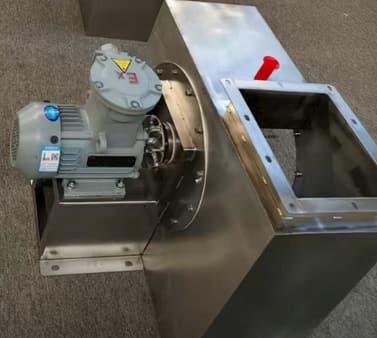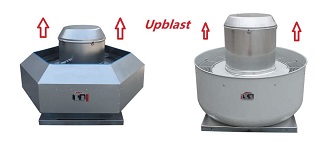Upblast vs. Downblast Ventilation Systems for Roof Exhaust Fan
In commercial and industrial ventilation design, roof exhaust fans play a pivotal role in removing contaminated or heated air from buildings. One key decision can greatly affect system performance, air quality, and even nearby environmental conditions: the direction of exhaust airflow.
Roof exhaust fans primarily come in two configurations—upblast and downblast. While both serve the purpose of exhausting air, their airflow trajectory, application scenarios, and safety implications differ significantly. At Zhejiang Shuangyang Fans Holding Co., Ltd, we offer both upblast and downblast roof fans engineered for efficient, compliant, and long-term performance across diverse industries.
What Are Upblast and Downblast Fans?
✅ Upblast Roof Exhaust Fan
Discharges air vertically upwards into the atmosphere. Typically equipped with a conical hood to help redirect airflow and protect the fan from weather.
✅ Downblast Roof Exhaust Fan
Directs exhausted air downward toward the rooftop surface. Often used with ductwork or duct collars to route air through a defined path before discharge.
While both fan types are mounted on rooftops, the orientation of discharge airflow makes a functional and safety difference, especially in buildings where air recirculation or contaminant dispersion is a concern.
Functional Differences
Feature | Upblast Exhaust Fan | Downblast Exhaust Fan |
|---|---|---|
| Air Discharge Direction | Vertical (upward) | Vertical (downward) |
| Contaminant Handling | Ideal for grease-laden, chemical, or hot air | Best for general ventilation (e.g. office buildings) |
| Recirculation Risk | Lower (disperses into atmosphere) | Higher if near intakes or vents |
| Weather Protection | Needs hood or rain cover | Often integrated with protective housing |
| Noise Direction | Upward dispersal (quieter at ground level) | May reflect downward if unshielded |
Application-Based Selection
✅ Upblast Fans: Industrial Kitchens, Chemical Plants, Foundries
Upblast fans are commonly used in environments where grease, oil vapor, chemical fumes, or smoke are exhausted. By directing the air vertically, these fans help ensure:
-
Reduced rooftop contamination
-
Minimized re-entrainment into HVAC intakes
-
Compliance with standards for kitchen exhaust systems
SHUANGYANG FAN provides spark-resistant and corrosion-proof upblast fans tailored for foodservice, manufacturing, and hazardous zone applications. Many models feature high-temperature motors, belt or direct drive configurations, and optional roof curb adaptors.
✅ Downblast Fans: Schools, Office Buildings, Toilets, Warehouses
Downblast fans are better suited for non-hazardous air, such as stale indoor air, heat buildup, or low-particulate exhaust. Their compact design and downward discharge:
-
Reduce wind uplift on fan structure
-
Simplify duct connections in flat-roof buildings
-
Offer aesthetic benefits in urban areas
Our low-noise downblast fans are widely used in public buildings where acoustic comfort and energy savings are priorities.
Engineering Considerations
✅ Back Pressure and System Resistance
Upblast fans often handle higher static pressure, particularly when ducted systems are minimal. Downblast models, depending on duct length and layout, may face higher resistance that requires precise fan curve matching.
✅ Roof Exhaust Fan Selection
At SHUANGYANG FAN, we simulate airflow conditions using CFD software and provide selection guidance via performance curves to ensure that the chosen fan type delivers optimal CFM and pressure under real-life conditions.
✅ Rain and Snow Protection
Upblast configurations require effective drain pans or grease traps to avoid rooftop contamination. In cold climates, anti-icing coatings and snow-guard designs may be essential. Downblast units often benefit from built-in rain caps or side-mounted dampers.
Based on airflow modeling and contaminant dispersion analysis, we recommended:
-
Upblast fans for pathology labs and kitchens
-
Downblast fans for general staff restrooms and administrative blocks
This dual approach reduced construction costs and ensured code compliance without overengineering.
Materials, Noise Control, and Customization
To address diverse client needs, we offer:
-
Aluminum, stainless steel, or FRP housing options
-
Acoustic insulation and vibration dampers
-
EC motors with variable speed drives (VSDs)
-
Explosion-proof versions for ATEX/IECEx environments
All fans are factory-tested, ensuring performance verification before delivery.
Read More about SHUANGYANG FAN
Note: The content of the article cannot avoid omissions and errors. Welcome to propose corrections.
 Mancooler (Workstation) Fans — Why Your Factory Needs the Right One
Mancooler (Workstation) Fans — Why Your Factory Needs the Right One
 Motor Classifications in Industrial Fans
Motor Classifications in Industrial Fans
 Materials for Explosion-Proof Fan
Materials for Explosion-Proof Fan
 Direct Drive vs. Belt Drive in Axial Fan and Centrifugal Fan
Direct Drive vs. Belt Drive in Axial Fan and Centrifugal Fan



